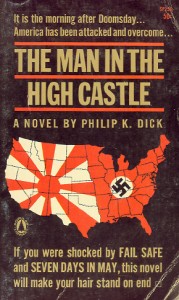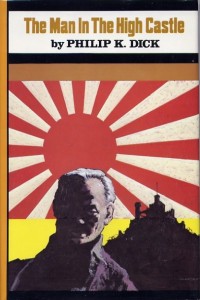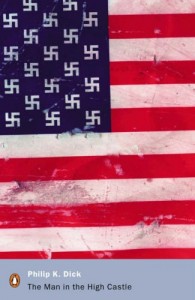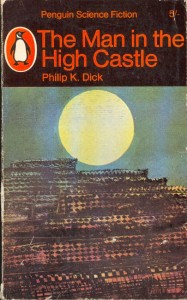As a historian of religion, I am haunted by Zippo cigarette lighters.
Let me explain. As a teenager, I was stunned by reading Philip K. Dick’s novel The Man in the High Castle, originally published in 1962. The book’s theme seems almost commonplace in retrospect, as so many other works have used its central idea of “What if the Axis won the war?” Counter-factual history (“virtual history”) is now very much in vogue. At the time, though, Dick’s work was far more unusual, and still, in retrospect, it finds few competitors. (WARNING: SOME SPOILERS FOLLOW)
Dick portrays an alternate world of 1962, in a California occupied by the Japanese. The Germans own the eastern half of North America, and much of the rest of the world. In this alternative society, an author creates a sensation by publishing a far-fetched novel called The Grasshopper Lies Heavy, imagining what might have happened in case the Allies might have won the war.
Alternate world books are often quite predictable: High Castle isn’t. It’s a meditation on the nature of historical fact, and of the means by which we can tell the difference between reality and fantasy. We see this from a scene in which a Japanese official momentarily slips into a bizarre alternative San Francisco, in which he is not one of the feared occupiers, but a confused Asian who is subjected to ethnic insults on the street: in other words, the “real” world that we know, or think we know.
One of Dick’s central characters, Wyndam-Matson, survives by selling historical curios, which are mostly forged. As he explains to a girlfriend, the whole business of authenticity and historicity is wildly overhyped, as he illustrates from a pair of cigarette lighters:
“ ‘Look at these. Look the same, don’t they? Well, listen. One has historicity in it.’ He grinned at her. ‘Pick them up. Go ahead. One’s worth, oh, maybe forty or fifty thousand dollars on the collectors’ market.’
The girl gingerly picked up the two lighters and examined them. ’Don’t you feel it?’ he kidded her. ‘The historicity?’ She said, ‘What is ‘historicity’?’ ’When a thing has history in it. Listen. One of those two Zippo lighters was in Franklin D. Roosevelt’s pocket when he was assassinated. And one wasn’t. One has historicity, a hell of a lot of it. As much as any object ever had. And one has nothing. Can you feel it?’ He nudged her. ‘You can’t. You can’t tell which is which. There’s no ‘mystical plasmic presence,’ no ‘aura’ around it.’
‘Gee,’ the girl said, awed. ‘Is that really true? That he had one of those on him that day?’ ‘Sure. And I know which it is.’ “
(The reader tends to enter into this scene so thoroughly that you need to be reminded that, no, FDR did not perish at an assassin’s hand in Miami in 1933.)
After some debate, she remains unconvinced:
“ ‘I don’t believe either of those two lighters belonged to Franklin Roosevelt,’ the girl said.
Wyndam-Matson giggled. ‘That’s my point! I’d have to prove it to you with some sort of document. A paper of authenticity. And so it’s all a fake, a mass delusion. The paper proves its worth, not the object itself!’
‘Show me the paper.’
‘Sure.’ Hopping up, he made his way back into the study. From the wall he took the Smithsonian Institution’s framed certificate; the paper and the lighter had cost him a fortune, but they were worth it – because they enabled him to prove that he was right, that the word ‘fake’ meant nothing really, since the word ‘authentic’ meant nothing really. “
A bogus paper, fraudulently obtained, vouches for the authenticity of a bogus object, but once people agree to suspend disbelief and accept it, that object becomes immensely valuable. And thus is history born.
On first reading, you pass quickly over the lighter scene as a piece of cynical humor, but after completing the book, you realize it is the key critical moment of the whole work. Indeed, it raises the questions fundamental to the story, and to much of Dick’s literary output. So much depends on themes of fake, forgery and reproduction.
So is the world of his novel real or not? Alternatively, is the world of The Grasshopper Lies Heavy real? Or both, or neither? How do we know? How can the characters of Man In The High Castle possibly find out which is the reality – and how can we?
Put another way, what is real history and how do we know? Is history anything more than consensus illusion? Is historical reality fixed or constructed? Is history only in the mind of the beholder? If people stop believing in an event, does it become untrue?
Such questions might seem like paranoid delusions, and Dick’s personal hold on mainstream reality was often tenuous. But these are excellent questions to ask about the writing of history, which is so notoriously subject to fads and fashions. Any and all historical assumptions are subject to endless revisionism. The enormous modern growth of mass media vastly accelerates the process by which historical events are discovered, reinterpreted, and, yes, forgotten. Events and trends that seem crucially important to one generation often slip from the awareness of the next, and vice versa.
For a generation now, historians have been obsessed with ideas of memory and commemoration, on the construction of history, though few of these ideas have filtered through to the public. Within the profession, at least, there has been a massive shift of sensibility from the task of finding what happened to studying how we re-imagine what happened. In studying the American Civil War, for instance, a great many historians are now studying not the battles themselves, but the monuments built after the war, and the ways in which the battles were remembered and misremembered. Ditto the First World War, in both the US and Europe.
If I can alter the familiar quote, those who do not recall the past are doomed to write books about the politics of memory.
On this very blog, several contributors have addressed the historical construction (and mythologizing) of such events as Thanksgiving, or the religious role in the Declaration of Independence. Significantly, the process of myth-making over time has often been accompanied by the invention of spurious documents, such as the alleged proclamation quoted today as the foundation text of Thanksgiving.
And what does all this tell us about the historicity, the aura, of places and objects? Again, how much does such an ambience depend on what people bring to it, often based on quite inaccurate historical interpretations? This comes to mind when we look at the world of historical re-enactors, or collectors of antiquities. What kind of quality do those “historic” places or objects possess? What are collectors really collecting, and re-enactors re-enacting? That question is doubly loaded when we examine places vested with sanctity, and what visitors or pilgrims find there.
I had a powerful sense of déjà vu recently reading a thoughtful essay by Ken Johnson of the New York Times on the question of “What Puts Soul in a Masterpiece?” A well publicized case of art forgery led Johnson to ask,
Why should we value a painting known to be made by a certain esteemed artist more than a painting that is phony but is nevertheless practically indistinguishable from the authentic work? Why is a real Motherwell worth millions of dollars more than a fake one that looks just as good?… Demand is partly animated by some quasi-magical beliefs about art and artists, like the idea that there’s a sort of organic connection between artists and the things they make. The artist’s soul is somehow in the work, and because great artists are supposed to have great souls, there’s more soul in their creations than there is in mediocre efforts. From there, it’s a short leap of faith to the belief that market valuation reflects soul value — not perfectly, but at least roughly and in the long term. The most expensive works have the most soul. That’s why, if you can afford it, you buy the real Motherwell. There’s no magic, no soul, in fake artworks, so they are worth less, if not completely worthless.
It’s well worth reading.
Incidentally, I read Man in the High Castle in 1966, and it influenced me profoundly. You’ll see why I was less than impressed when Baudrillard and the post-modernists enjoyed such a vogue in the 1980s. For any science fiction fan, those supposedly cutting-edge ideas were old hat.
Please tell me that 1966 wasn’t almost half a century ago…
















